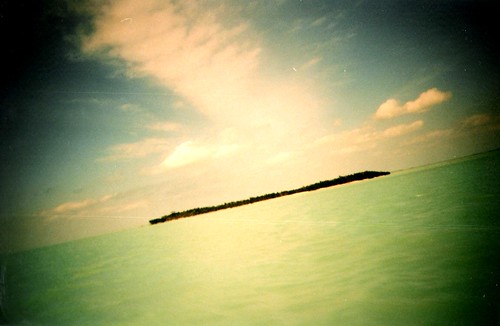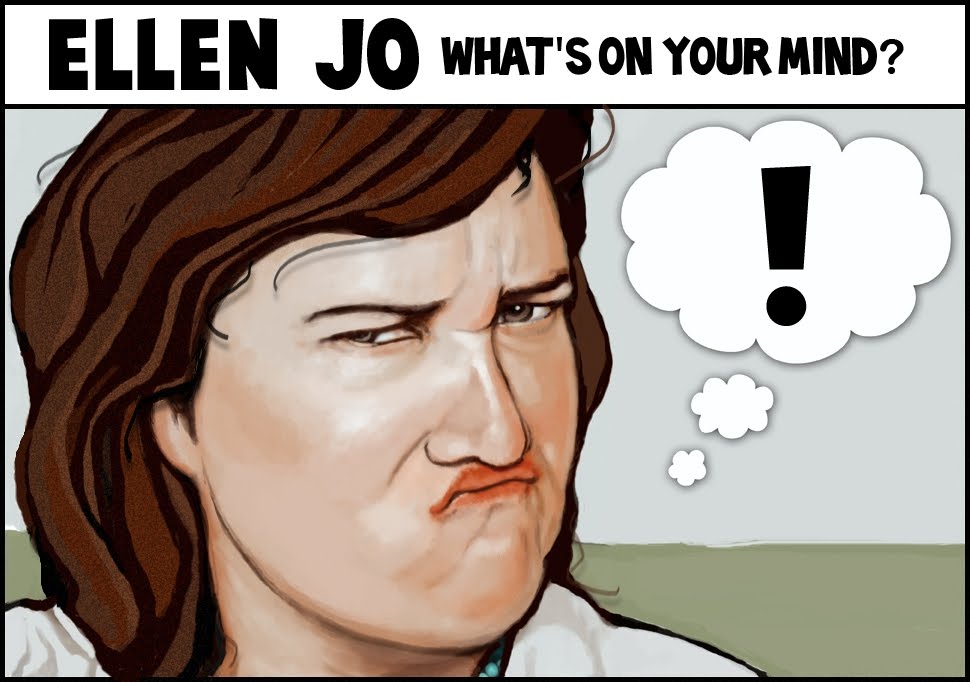By Ellen Jo Roberts
March 2012
The Outs
The Noise

When we travel we aim for the authentic. Back before there was a matching Cracker Barrel at every interstate exit ramp, back before corporations created theme vacation packages, there were authentic places native to each region. In addition to natural highlights of the landscape, there were many distinctly un-natural landmarks not to be missed: Elizabeth, a building shaped like an elephant along the shore in Margate, New Jersey; The Corn Palace of Mitchell, South Dakota, decorated each year with new murals made from multi-colored kernels of corn; Dinny and Rex, colossal concrete dinosaurs presiding over California’s Coachella Valley; The Cadillac Ranch, a row of 10 graffiti-encrusted Caddies ranging in model year from 1949-1963, buried in a Texas field along Route 66. These places and others like them still exist, dotting the United States from sea to shining sea, along historic highways and forgotten roads, some kitschy, some artistic and all created with the intention of luring visitors. Arizona is lucky to have plenty of national parks, monuments and historic towns to lure travelers, but we also are home to more obscure attractions. The Hi Jolly monument in Quartzite commemorates US Army camel trainer, Hadji Ali. The actual real life London Bridge in Lake Havasu City was imported to Arizona in 1968 by Robert McCulloch. A mural and statue on a corner in Winslow, Arizona pays tribute to The Eagles’ 1972 hit (co-written by Jackson Browne) “Take it Easy”.
Fellow tourism state Florida is a perfect case study on the topic of new and old attractions.
Before Disney's corporate vision absorbed most of central Florida in the 1970s, small-time attractions like gator-wrestlin' and air-boat tours of the swamp land were prime tourism draws of the Sunshine State.

Me and Florida, we go way back. First time I was ever on an airplane was during a trip to Orlando when I was 10. Typical of early '80s style, I wore bright banana yellow pants to the airport with a striped yellow frilly-shouldered shirt. Florida seemed like a magic dreamscape: a balmy green jungle full of clowns, costumes, coconuts and palm trees, shells and sand, scented with sea and citrus and sparked with fantastic lightning shows. My husband's family caught the Florida bug in the 1980s too, spending many winter holidays in the Keys.

His folks later bought a condo in Key Largo, which provided us many tropical escapes over the decades, paddling sea kayaks through the saltwater Caribbean back country, skirting along the mangroves and manatees, hooking and cooking snappers and sheepshead and other abundant native fish. Even my Chihuahua has even been to Florida, more than once. We love it. It's an enchanting land, rumored to be the legendary fountain of youth! Our dry desert wrinkles vanish and our hair curls in the humidity making us feel like teenagers again. Despite all the magic, saltwater and sweet scents, we've just never considered moving there. Too many people, too flat, too many mosquitoes, too many hurricanes.
“Speaking about tornadoes,
The hurricane's the worst of all
They come and go through Florida
Blow down 14 feet of wall.
Hurricane is so powerful
Blow the house away where I live.
It make hair rise on your head,
Gives you fever and cold chill.
Winter clothes are not needed.
You spend money rebuilding your home.
When the ocean gets rough,
You're not in Florida all day long.
I really like Florida,
If the winds don't blow me away.
Lord I really like Florida
If the winds don't blow me away.
But if that don't never happen,
I'll be in Florida the rest of my days."
-"Florida Hurricane" c. 1948, St Louis Jimmy/ Muddy Waters
Florida juts to into the sea like a phallus. Almost an island, but settling for peninsula. All of its coasts are spring break meccas, so I always think of Florida this time of year. On St. Patrick's Day 1994, I walked the cool night night breeze of Key West in bowling shoes and cut-off shorts, sipping from a Tropicana bottle half filled with rum, my hair wild and wooly with salt water and sand from our three nights camping on an island in the Everglades. With its liberal strongholds in the south and conservative central and north, Florida is an interesting blend of old and new money, snow birds, immigrants from Cuba, Canada, the West Indies, Africa and Eastern Europe, all layered atop 300 years of Old South culture.

Before corporate tourism homogenized everyone's holidays, old timey attractions drew visitors from near and far for their authenticity. Gatorland bills itself as "Florida's First Theme Park". Located in Orlando since 1949, the park catches interest with its toothy gator jaw front entrance, a local icon looming over the roadside since its early days. Gatorland features 110 acres of alligators and crocodiles from all over the globe. Shows like the "Gator Jumparoo" where alligators leap for raw chicken, and the "Gator Wrestlin' Show" can only be described as old timey American weirdness at its best. Many "problem" alligators are relocated to the park from throughout Florida, captured from communities where they've eaten too many pets and disrupted too many golf games. There are thousands of the prehistoric creatures here, everywhere you turn, and all of them so beautiful you feel like you really understand something important about Florida.

A close encounter with a Cuban Crocodile may leave emotional. She hypnotizes you with her soulful eyes and seems so docile (though the sign describes the species as quick and cooperative hunters, similar to the “Velociraptor” character from Jurassic Park, able to work in teams and leap high…perhaps higher that that fence she's behind). After we walk on to the next exhibit, I miss her and the amazing patterns on her leathery skin. The park also features a tiny train ride, an aviary and breeding marsh with observation tower, petting zoo, nature walk, and educational wildlife programs. But no frills, few gimmicks, no movie tie-ins. And on a winters day the parking lot is so crowded you must wait for a spot.
Not far from Gatorland, in an area known as Florida's Nature Coast, colossal fresh water springs gurgle sparkling blue, sending thousands of gallons of fresh water out towards the Gulf of Mexico each minute. In one of these springs, the one called the Weeki Wachee, there are mermaids! Swimming with their sparkly fins, sharing their stage with native fish and amphibians, the Weeki Wachee Mermaids have been performing in their underwater amphitheater since 1947. It's amazing to think that, in the world of pre-packaged Disney adventures with mega–marketing campaigns, something as charming and small scale as the Weeki Wachee Mermaids could still exist. They anchor the old time Florida with their three shows a day, performing 30 minutes submerged while sipping air from hoses.

Sitting in the underwater auditorium looking into the spring like an aquarium, I feel like a kid again. I’m so excited I can barely sit still on the hard wooden bench seats. The soundtrack is piped in over the audience and the performers gracefully pantomime along with the dialogue and songs in their sleek mermaid costumes, air bubbles acting as exclamation points. The price to see the show was something crazy cheap like $12, and afterwards you may pose for photos with one of the mermaids, a doppleganger for Darryl Hannah in Splash.
Another natural spring, not far from Weeki Wachee, offers an interesting modern tale of old tourism and new. Rainbow Springs in Dunnellon is now part of the Florida State Park system, but from 1930 until the early 1970s it was a theme park, complete with a monorail, zoo, rodeo, artificial waterfalls and glass bottom boat tours. Florida’s 4th largest freshwater spring is a crystal clear travertine blue, a steady 72 degrees year-round. Cornville resident Kim Poucher grew up in Dunnellon and has fond memories of the park, “My earliest and coolest recollections of Rainbow Springs was when they had the glass bottom boats and old man Captain Skipper Lockett reeling off the names of the fish and vegetation. Sounded like rap music! When it shut down, I guess mid-70's, we kids had a wonderful time sneaking around up there. There was a monorail about 30 feet off the ground that we would walk on top of through the whole park.”
Disneyland had already enjoyed 16 years of success in California before expanding the empire into central Florida. Disneyworld opened in October of 1971, inspiring a whole region of similar attractions, luring visitors away from old time parks like Rainbow Springs.

In 1972 the U.S. Department of the Interior designated Rainbow River a National Natural Landmark and in the mid-1990s it reopened the property as a state park. It’s a lesson in modern methodology, because in the 21st Century it’s unlikely that a beautiful natural feature would be “enhanced” with commercial venture, girdled with a monorail, and converted into an amusement park. The harnessing and redirecting of natural wonders is a notion that began to lose steam in the mid- 20th century, with the first wave of ecology consciousness. So, in becoming a state park, Rainbow Springs has been allowed to revert back to the wild. Ruins from the theme park days remain, adding to the intrigue. Pilons from the monorails stand guard and deserted cages of the small zoo are overgrown with tropical brush.

Walking the park gives an enchanted feeling, slightly surreal like a dream. The springs are a popular spot with swimmers, canoeists and kayakers as well as native birds, fish and reptiles.

Florida is one of the world’s most popular tourism locations for its sand, surf, tropical climate and coastal beauty…and its epic theme parks. There is an old time Florida that still thrives along the back roads where stands full of fresh oranges entice motorists. Just as in any state, there are the authentic tastes of local culture: the places you cannot find anywhere else. Much as it’s important to be a locavore, consuming locally and regionally grown foods, let us also espouse the locatour, participating in locally-conceived tourism, imagined outside of a corporate headquarters. When you find a unique place on your travels, be it a mermaid show, giant dinosaur, weird museum or a row of Cadillacs half-buried in a field, you must go there. Someone wanted you to visit and you must heed the call.

Ellen Jo Roberts celebrates her birthday at the end of this month. Send cards and money.
www.ellenjo.com
